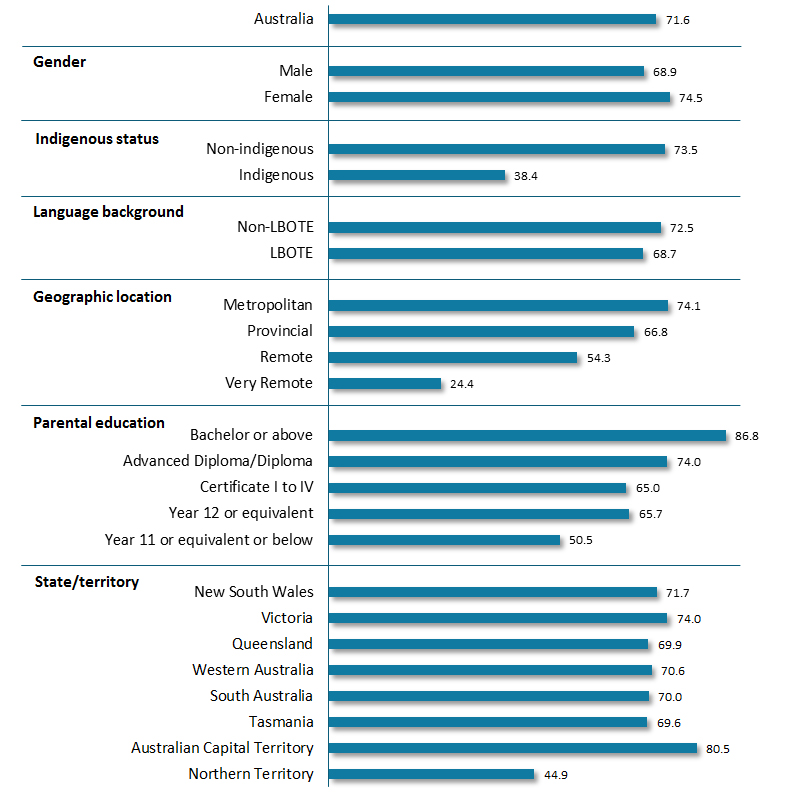Middle years: Achievement gaps widen at Year 7

The middle years of schooling are an important stage for students to build on their foundations and develop the capabilities and confidence for future learning and academic achievement.
This is a crucial juncture in learning as students are in the transition phase between primary and secondary schooling.
Educational opportunity in Australia 2015 is one of the most comprehensive data studies of Australia’s education system. It examines young people’s progress on four key educational milestones, from the early years right through to young adulthood. In this fact sheet we look at the middle years milestone, when students are aged 13-14 years.
Key findings
- Just under three-quarters (72 per cent) of all 13-14 year olds meet the milestone at Year 7; this increases their chances of acquiring the foundational skills they need in later years.
- An estimated 73,000 13-14 year olds (28 per cent) are not meeting expected standards in academic skills; this means the education system is failing to prepare these students for learning in later years.
- Due to a combination of risk factors, the gap between Indigenous and non-Indigenous students grows at Year 7, with Indigenous students 2.3 times more likely to miss out on the milestone than their non-Indigenous peers (62 per cent versus 27 per cent).
- Males are more likely to miss out on the reading benchmark at this milestone than females (31 per cent versus 26 per cent). But females are more likely to miss out on the benchmark for numeracy (32 per cent versus 29 per cent).
- Some children, who did not meet the first milestone at entry to school, improve during primary school and succeed at the Year 7 milestone. This is affirming information because it suggests that schools can bridge gaps and can help young people overcome set-backs.
Percentage of students meeting the milestone at Year 7

Graph text alternative
Graph showing the percentage of young Australians meeting the middle years milestone at Year 7. The data shows that 71.6 per cent of young Australians meet this milestone and then shows percentages by gender, Indigenous status, language background, geographic location, parental education and state/territory. The results are as follows: Gender - 68.9% of males, 74.4% of females; Indigenous status - 38.4% Indigenous, 73.5% non-Indigenous; Language background - non-LBOTE 72.5%, LBOTE 68.7%; Geographic location - ranging from 24.4% of those in very remote locations to 74.1% of those in metropolitan locations; Parental education - ranging from 50.5% with Year 11 or equivalent or below to 86.8% with Bachelor of above; State/territory - ranging from 44.9% in Northern Territory to 80.5% in Australian Capital Territory.
Source: Educational opportunity in Australia 2015, CIRES for the Mitchell Institute
What does this tell us?
At the previous milestone, we saw that 22 per cent of Australian children are missing out on the foundational skills they need as they enter school. We noted that of all the factors that increase the risk of not meeting the milestone at school entry, a child’s socio-economic background has the strongest effect.
At the Year 7 milestone, we see that significant numbers of children are still not being supported to stay on track (28 per cent) including some of those who were doing well at the early years milestone. For these young students, the primary school years have not helped them to build the essential skills they need, particularly for students from disadvantaged backgrounds and non-metropolitan areas. We see that students in these groups are more likely to be missing out by Year 7 and less likely to catch up again than their more advantaged peers.
The impact of family wealth increases as gaps widen, though some students move back on track.
The middle years are not only about academic learning. During this time, students develop essential life skills, and develop a connection to school and learning that fosters educational success. Students who did not meet the milestone at Year 7 were less likely to have formed positive views of themselves as learners and their relationship to school, compounding the challenges they faced in academic achievement.
Compared to other similar countries like Canada and New Zealand, Australia has a highly segregated education system. While many schools, teachers and communities achieve strong gains for students at risk, the education system overall does an inadequate job of mitigating the effects of socio-economic disadvantage on learning during the primary to middle years. Increasingly, the most advantaged students are concentrated in the highest-achieving schools, and the achievement gaps continue to widen.
Resources must be directed to where they are needed most and we must focus our educational investment on keeping all students on track and helping them to succeed during this crucial transition period.
The model proposed in the (Gonski) Review of Funding for Schooling to provide sector-blind, needs-based funding offers a sophisticated and fair approach to allocating funding. Jurisdictions are now implementing needs-based funding in different ways, to recognise the different levels of challenge faced by schools in achieving positive outcomes for their student populations.
This kind of model is an essential precondition to creating more equality of opportunity, but funding alone is not enough. Systems need to ensure that schools are supported to ensure any additional funding is spent where it is needed.
About this milestone - what was measured?
The middle years milestone looked at the academic outcomes of Australian students at Year 7 – examining which students were at the mid-point of the third achievement band for the National Assessment Program Literary and Numeracy (NAPLAN) in reading. This is a slightly higher standard than the National Minimum Standard for NAPLAN, but was chosen as it is more consistent with the standard expected in international tests.
Fact sheets in this series
- Fact sheet 1 – Socio-economic disadvantage and educational opportunity persistently linked
- Fact sheet 2 – Early years: Gaps in educational opportunity evident at entry to school
- Fact sheet 3 – Middle years: Achievement gaps widen at Year 7
- Fact sheet 4 – Senior school years: School completion uneven across Australia
- Fact sheet 5 – Post-school years: Many 24 year olds marginalised, but second chances help
- Fact sheet 6 – Young people in rural and remote communities frequently missing out
More information
Educational opportunities in Australia 2015 was prepared by the Centre for International Research on Education Systems at Victoria University for the Mitchell Institute.



